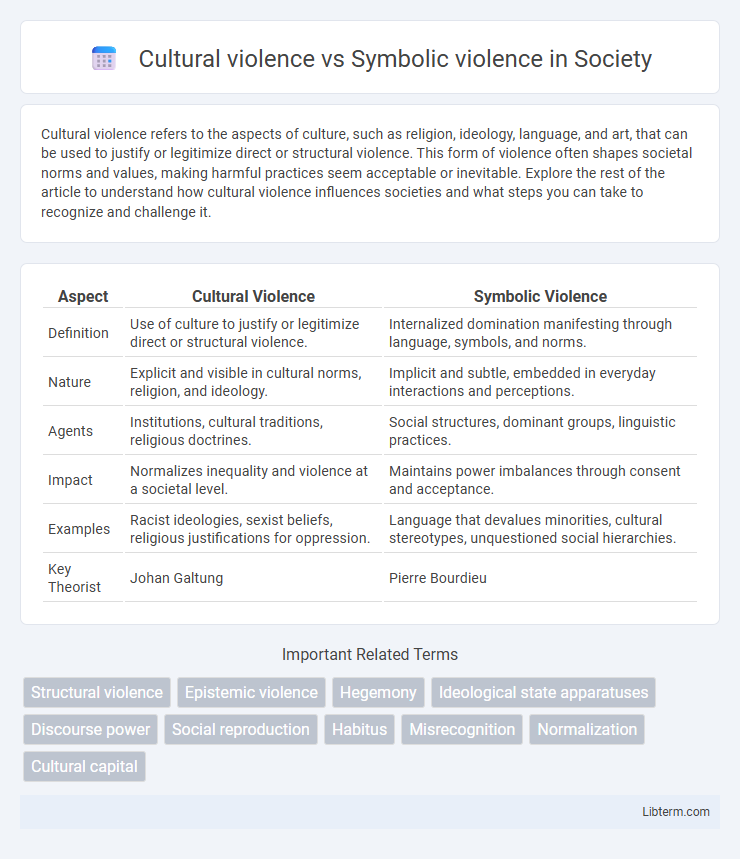Cultural violence refers to the aspects of culture, such as religion, ideology, language, and art, that can be used to justify or legitimize direct or structural violence. This form of violence often shapes societal norms and values, making harmful practices seem acceptable or inevitable. Explore the rest of the article to understand how cultural violence influences societies and what steps you can take to recognize and challenge it.
Table of Comparison
| Aspect | Cultural Violence | Symbolic Violence |
|---|---|---|
| Definition | Use of culture to justify or legitimize direct or structural violence. | Internalized domination manifesting through language, symbols, and norms. |
| Nature | Explicit and visible in cultural norms, religion, and ideology. | Implicit and subtle, embedded in everyday interactions and perceptions. |
| Agents | Institutions, cultural traditions, religious doctrines. | Social structures, dominant groups, linguistic practices. |
| Impact | Normalizes inequality and violence at a societal level. | Maintains power imbalances through consent and acceptance. |
| Examples | Racist ideologies, sexist beliefs, religious justifications for oppression. | Language that devalues minorities, cultural stereotypes, unquestioned social hierarchies. |
| Key Theorist | Johan Galtung | Pierre Bourdieu |
Understanding Cultural Violence: Definition and Examples
Cultural violence refers to aspects of culture, such as religion, language, and art, that justify or legitimize direct or structural violence by embedding it deeply in societal norms and beliefs. Examples include discriminatory traditions or media representations that normalize inequality, while symbolic violence is a subtle form of coercion where dominant groups impose their values and perceptions, making oppression appear natural or deserved. Understanding cultural violence requires examining how cultural narratives perpetuate power imbalances and normalize harm across generations.
Defining Symbolic Violence: Roots and Manifestations
Symbolic violence, rooted in Pierre Bourdieu's theory, refers to the subtle imposition of dominant cultural norms and values that reinforce social hierarchies through language, symbols, and everyday practices. Unlike overt cultural violence, which involves explicit acts of aggression or discrimination, symbolic violence operates through unconscious acceptance and legitimization of inequality by marginalized groups. Manifestations include institutional biases, linguistic domination, and the internalization of inferiority, perpetuating social control without physical force.
Historical Contexts of Cultural and Symbolic Violence
Cultural violence manifests through entrenched historical narratives, rituals, and institutional practices that legitimize direct and structural violence across societies. Symbolic violence, a concept developed by Pierre Bourdieu, operates subtly by internalizing power imbalances through language, norms, and symbols rooted in colonialism and class dominance. Historical contexts reveal how cultural and symbolic violence reinforce systems of oppression by normalizing inequality and obscuring contestation in social relations.
Key Differences Between Cultural and Symbolic Violence
Cultural violence refers to aspects of culture that justify or legitimize direct or structural violence, such as religion, ideology, language, art, and science, embedding harmful norms within societal values. Symbolic violence is a form of power exercised through subtle, often unnoticed imposition of dominant cultural norms, leading to internalized oppression and consent among marginalized groups. The key differences lie in cultural violence being overtly legitimizing violence within society's framework, whereas symbolic violence operates covertly through cultural symbols and practices that reinforce unequal power relations without direct physical force.
How Cultural Violence Shapes Social Norms
Cultural violence embeds ideologies within societal symbols, language, and rituals, shaping social norms by legitimizing inequality and power imbalances. Through repeated cultural practices and narratives, such violence normalizes discrimination and marginalization, making structural violence appear acceptable or invisible. This process influences collective behavior and attitudes, reinforcing social hierarchies and perpetuating systemic oppression.
The Mechanisms of Symbolic Violence in Everyday Life
Symbolic violence operates through subtle, everyday practices where dominant cultural norms are internalized, reinforcing social hierarchies without overt force or coercion. It manifests in language, education, and media, shaping perceptions and legitimizing inequality by making dominated groups accept their subordinate status as natural. Unlike cultural violence, which justifies physical harm and structural oppression through ideology, symbolic violence invisibly perpetuates power relations by aligning individual habitus with dominant interests.
Impact on Marginalized Groups: Cultural vs Symbolic Violence
Cultural violence legitimizes structural inequalities by embedding discriminatory norms within societal values, significantly affecting marginalized groups by normalizing their exclusion. Symbolic violence operates through subtle, often unconscious, dominance in everyday interactions, leading marginalized individuals to internalize inferiority and accept their oppression. Both forms perpetuate systemic marginalization, but symbolic violence directly shapes personal identity and self-perception, deepening social alienation.
Media Representation and the Perpetuation of Violence
Media representation plays a critical role in perpetuating both cultural violence and symbolic violence by normalizing oppressive narratives that reinforce existing power hierarchies. Cultural violence manifests through media content that legitimizes discrimination and dehumanization, thereby embedding structural inequalities into societal norms. Symbolic violence operates via subtle media portrayals that shape perceptions and internalize domination, maintaining social inequities without overt physical force.
Strategies for Recognizing and Challenging Invisibility
Cultural violence manifests through accepted norms and values that justify direct or structural violence, often hidden within societal traditions and ideologies. Symbolic violence operates through subtle, often unconscious mechanisms, such as language and representation, reinforcing power imbalances and social hierarchies. Effective strategies for recognizing and challenging invisibility include critical discourse analysis, amplifying marginalized voices, and fostering awareness of dominant narratives that normalize exclusion and oppression.
Towards Social Change: Addressing Cultural and Symbolic Violence
Cultural violence refers to aspects of culture that justify or legitimize direct or structural violence, embedding harm within societal norms, beliefs, and values. Symbolic violence, a concept developed by Pierre Bourdieu, denotes the subtle, often unnoticed imposition of dominant cultural meanings that sustain social inequalities and power imbalances. Addressing cultural and symbolic violence requires transformative social change strategies that challenge dominant ideologies and empower marginalized voices through education, policy reform, and inclusive dialogue.
Cultural violence Infographic

 libterm.com
libterm.com